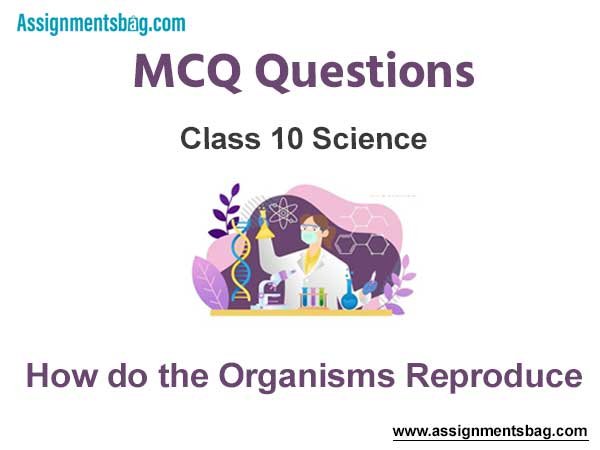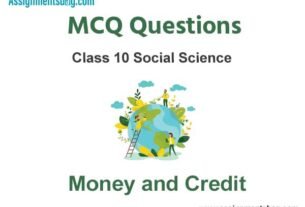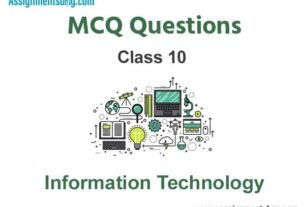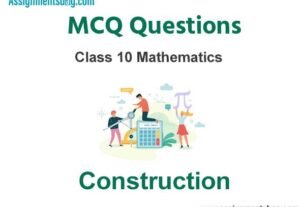Please refer to MCQ Questions Chapter 8 How do the Organisms Reproduce Class 10 Science with answers provided below. These multiple-choice questions have been developed based on the latest NCERT book for class 10 Science issued for the current academic year. We have provided MCQ Questions for Class 10 Science for all chapters on our website. Students should learn the objective based questions for Chapter 8 How do the Organisms Reproduce in Class 10 Science provided below to get more marks in exams.
Chapter 8 How do the Organisms Reproduce MCQ Questions
Please refer to the following Chapter 8 How do the Organisms Reproduce MCQ Questions Class 10 Science with solutions for all important topics in the chapter.
MCQ Questions Answers for Chapter 8 How do the Organisms Reproduce Class 10 Science
Question. Which of the following is the correct sequence of events of sexual reproduction in a flower?
(а) pollination, fertilisation, seedling, embryo
(b) seedling, embryo, fertilisation, pollination
(c) pollination, fertilisation, embryo, seedling
(d) embryo, seedling, pollination, fertilisation
Answer
C
Question. The full form of AIDS is
(a) Acquired Immune Deficiency System
(b) Acquired Immune Disease Syndrome
(c) Acquired Immediate Deficiency Syndrome
(d) Acquired Immuno Deficiency Syndrome
Answer
D
Question. The common passage meant for transporting urine and sperms in males is
(a) Ureter
(b) Vas deferens
(c) Urethra
(d) Anus
Answer
C
Question. In Spirogyra, Asexual Reproduction Takes Place By
(а) Breaking up of filaments into smaller bits
(b) Division of a cell into two cells
(c) Division of a cell into many cells
(d) Formation of young cells from older cells
Answer
A
Question. Which among the following does not reproduce by spore formation:
(a) Penicillium fungus
(b) Yeast fungus
(c) Mucor fungus
(d) Rhizopus fungus
Answer
B
Question. Reproduction is essential for living organisms in order to ……………………
(a) Keep the individual organism alive
(b) Fulfill their energy requirement
(c) Maintain growth
(d) Continue the species generation after generation
Answer
D
Question. IUCD is for
(a) Vegetative propagation
(b) Contraception
(c) Increasing fertility
(d) Avoiding miscarriage
Answer
B
Question. The fate of placenta is to :
(а) provide nutrition to embryo
(b) provide support to embryo
(c) provide minerals to zygote
(d) none
Answer
A
Question. AIDS is a deadly disease which is caused by
(a) a protozoan
(b) a fungus
(c) a bacterium
(d) a virus
Answer
D
Question. Tubectomy is carried out by blocking the
(a) oviduct
(b) uterus
(c) cervix
(d) vagina
Answer
A
Question. What can be concluded about the division in plasmodium?
(a) The cyst divides repeatedly to form many daughter cells.
(b) The cell divides multiple times giving rise to many daughter cells.
(c) The nucleus divides repeatedly inside the cell to form new daughter cells.
(d) The cyst enlarges in size and then bursts producing many new daughter cells.
Answer
B
Question. Which event will likely occur in the ovaries of females after attaining puberty?
(a) fertilisation
(b) synthesis of eggs
(c) production of eggs
(d) growth and development of embryo
Answer
C
Question. Which is the portion on which grafting is done and it provides roots?
(а) stock
(b) scion
(c) both a and b
(d) none
Answer
A
Question. Which of the following is not a sexually transmitted disease?
(a) Warts
(b) Kala azar
(c) Syphilis
(d) Gonorrhoea
Answer
B
Question. (A) Vaginal pills contain spermicides.
(R) Spermicides kill the sperms.
(a) Both A and R are true and R is the correct explanation of A.
(b) Both A and R are true and R is not the correct explanation of A.
(c) A is true but R is false.
(d) A is false but R is true.
Answer
B
Question. Human beings are more genetically advanced than monkey because of:
(a) Fragmentation
(b) Reproduction
(c) Budding
(d) Variation
Answer
D
Question. Menopause occurs at the age of ______ years.
(a) 40-45
(b) 45-50
(c) 40-42
(d) 35-40
Answer
B
Question. (A) Errors in coping always create new body designs.
(R) DNA is the blueprint for body designs and characters.
(a) Both A and R are true and R is the correct explanation of A.
(b) Both A and R are true and R is not the correct explanation of A.
(c) A is true but R is false.
(d) A is false but R is true.
Answer
D
Question. The best preventive measure for sexually transmitted diseases (STD’s) is by the use of
(a) Condom
(b) Pills
(c) IUD (Intra-uterine device)
(d) None
Answer
A
Question. The ability of cell to divide into several cells during reproduction in the plasmodium is called _____.
(a) Budding
(b) Reproductive division
(c) Multiple fission
(d) Binary fission
Answer
C
Question. The lytic enzyme of sperm is ________
(a) ligase
(b) Acrosome
(c) hyaluronidase
(d) pepsin
Answer
C
Question. Symptoms of puberty in females are
(a) Enlargement of breast
(b) Initiation of the menstruation cycle
(c) Both
(d) None
Answer
C
Question. (A) Potato tuber is used for the vegetative reproduction of potato plant.
(R) Potato tuber is an underground stem of the potato plant.
(a) Both A and R are true and R is the correct explanation of A.
(b) Both A and R are true and R is not the correct explanation of A.
(c) A is true but R is false.
(d) A is false but R is true.
Answer
B
Question. Which among the following is not the function of testis at puberty ?
(a) Formation of sperms
(b) Releasing testosterone
(c) ovulation
(d) release of seminal fluid
Answer
C
Question. The ratio of number of chromosomes in a human zygote and a human sperm is:
(a) 1:2
(b) 2:1
(c) 1:3
(d) 3:1
Answer
B
Question. Which among the following statements are true for unisexual flowers?
(i) They possess both stamen and pistil
(ii) They possess either stamen or pistil
(iii) They exhibit cross pollination
(iv) Unisexual flowers possessing only stamens cannot produce fruits
(a) (i) and (iv)
(b) (ii), (iii) and (iv)
(c) (iii) and (iv)
(d) (i), (iii) and (iv)
Answer
B
Question. Which of the following method of contraception protects a person from acquiring a se*ually transmitted disease?
(a) Surgery
(b) Oral pills
(c) Condom
(d) Copper-T
Answer
C
Question. (A) Regeneration is getting a full organism back from its body parts.
(R) Hydra and Planaria show regeneration.
(a) Both A and R are true and R is the correct explanation of A.
(b) Both A and R are true and R is not the correct explanation of A.
(c) A is true but R is false.
(d) A is false but R is true.
Answer
B
Question. The seed contains the future plant or embryo which develops into a seedling under appropriate conditions, is known as
(a) Fermentation
(b) Reproduction
(c) Germination
(d) None of the above
Answer
C
Question. The number of chromosomes present in parents and offspring of a particular species remains constant due to ________.
(а) doubling of chromosomes during zygote formation
(b) Halving of chromosomes during gamete formation
(c) Doubling of chromosomes after gamete formation
(d) Halving of chromosomes after gamete formation
Answer
B
Question. Offspring formed as a result of sexual reproduction exhibit more variations because
(a) sexual reproduction is a lengthy process
(b) genetic material comes from two parents of the same species
(c) genetic material comes from two parents of different species
(d) genetic material comes from many parents
Answer
B
Question. The ability of cell to divide into several cells during reproduction in plasmodium is called __________.
(а) budding
(b) reproductive division
(c) Multiple fission
(d) BInary fission
Answer
C
Question. In human females, an event that reflects onset of reproductive phase is :
(а) Growth of body
(b) change in voice
(c) changes in hair pattern
(d) menstruation
Answer
D
Question. The offsprings formed by sexual reproduction exhibit more variations because _________.
(а) sexual reproduction is a lengthy process
(b) genetic material comes from two parents of same species
(c) genetic material comes from two parents of different species
(d) genetic material comes from many parents
Answer
B
Question. Syngamy is :
(а) fusion of male gamete and female gamete in humans
(b) fusion of male gamete and female gamete in non flowering plants
(c) fusion of egg cell and male gamete in non flowering plants
(d) fusion of egg cell and male gamete in flowering plants
Answer
D
Question. Which among the following statements are false for unisexual flowers?
(а) They always possess stamen and pistil
(b) they possess either stamen or pistil
(c) they show cross pollination
(d) unisexual flowers posessing only stamens can not produce fruits
Answer
A
Question. The two oviducts in human female unite in a bag called ________.
(а) vagina
(b) uterus
(c) cervix
(d) fallopian tube
Answer
B
Question. Which of these is not the function of the seminal vesicles present in human males?
(a) To covert the sperms in a fluid medium.
(b) To provide nutrition.
(c) To make their transport easier.
(d) To make them sticky.
Answer
D
Question. The asexual reproduction in the Spirogyra involves:
(a) Breaking up of filaments into smaller bits
(b) Division of a cell into many cells
(c) Division of a cell into two cells
(d) Formation of a large number of buds
Answer
B
Question. Which among the following are not the functions of testes at puberty?
(i) Formation of germ cells
(ii) Secretion of testosterone
(iii) Development of placenta
(iv) Secretion of estrogen
(a) (i) and (ii)
(b) (i) and (iii)
(c) (ii) and (iv)
(d) (iii) and (iv)
Answer
D
Question. The process of the transfer of pollen grains from the flower of one plant to the stigma of the flower of another plant of the same species is known as
(a) Cross pollination
(b) Fertilisation
(c) Self pollination
(d) None of the above
Answer
A
Question. What is the puberty age in human males?
(a) 8-10
(b) 10-12
(c) 12-14
(d) 14-16
Answer
C
Question. Why are both the vas deferens cut and tied in vasectomy?
(a) To stop the transport of sperms out to the female reproductive tract.
(b) To stop the sperm from fertilizing the secondary oocyte in oviduct.
(c) To stop sperm production.
(d) All the above
Answer
A
Question. When an organism breaks into a number of parts and each part develop into an individual, it is called –
(a) Budding
(b) Binary fission
(c) Regeneration
(d) Spore formation
Answer
C
Question. The fate of placenta is to:
(a) provide support to embryo
(b) provide nutrition to embryo
(c) provide minerals to zygote
(d) none of these
Answer
B
Question. In a list of organisms given below which is reproduced by asexual method?
(a) Banana
(b) Yeast
(c) Dog
(d) lion
Answer
B
Question. New plants can be produces without the help of any reproductive organ by:
(a) Vegetative propagation
(b) Regeneration
(c) Budding
(d) Fragmentation
Answer
A
Question. Eggs are formed in:
(a) Testes
(b) ovaries
(c) penis
(d) none
Answer
B
Question. Budding is found in:
(a) Planaria
(b) Hydra
(c) Leishmania
(d) All of these
Answer
A
Question. Variations occur as a result of
(a) asexual reproduction
(b) vegetative propagation
(c) sexual reproduction
(d) regeneration
Answer
C
Question. Fertilisation is the process of:
(a) transfer of male gamete to female gamete.
(b) fusion of nuclei of male and female gamete.
(c) adhesion of male and female reproductive organs
(d) the formation of gametes by a reproductive organ.
Answer
B
Question. The ability of a cell to divide into several cells during reproduction in Plasmodium is called:
(a) Budding
(b) Reduction division
(c) Binary fission
(d) Multiple fission
Answer
D
Question. Offspring formed by asexual method of reproduction have greater similarity among themselves because:
(i) Asexual reproduction involves only one parent
(ii) Asexual reproduction does not involve gametes
(iii) Asexual reproduction occurs before sexual reproduction
(iv) Asexual reproduction occurs after sexual reproduction
(a) (i) and (ii)
(b) (i) and (iii)
(c) (ii) and (iv)
(d) (iii) and (iv)
Answer
A
Question. In the following figure, different stages of binary fission in amoeba are depicted, which are not in the proper sequence (Image 174)
I II III IV
The correct sequence is
(a) II, III, IV, I
(b) I, II, IV, III
(c) III, IV, II, I
(d) I, III, IV, II
Answer
A
Question. Which one of the following permanently marks the end of menstrual cycle in females ?
(a) Menarche
(b) Menopause
(c) Ovulation
(d) Pregnacy
Answer
B
Question. The number of chromosomes in parents and offsprings of a particular species remains constant due to:
(a) doubling of chromosomes after zygote formation.
(b) halving of chromosomes during gamete formation.
(c) doubling of chromosomes after gamete formation.
(d) halving of chromosomes after gamete formation.
Answer
B
Question. In which of the following figures is buddin not shown? (Image 174)
(A) (B) (C) (D)
(a) A
(b) B
(c) C
(d) D
Answer
C
Question. Factors responsible for the rapid spread of bread mould on slices of bread are:
(i) Large number of spores
(ii) Availability of moisture and nutrients in bread
(iii) Presence of tubular branched hyphae
(iv) Formation of round shaped sporangia
(a) (i) and (iii)
(b) (ii) and (iv)
(c) (i) and (ii)
(d) (iii) and (iv)
Answer
C
Question. Which one of the following best describes the function of the umbilical cord?
(a) feeds the embryo with digested substances
(b) conveys nutrients and wastes to and from the embryo respectively
(c) removes waste matter from the embryo to the mother’s blood
(d) supplies oxygenated blood from the mother to the embryo
Answer
B
Question. Which among the following diseases is not sexually transmitted?
(a) Syphillis
(b) Hepatitis
(c) HIV-AIDS
(d) Gonorrhoea
Answer
B
Question. Slides of binary fission in Amoeba and
budding in yeast were given for observation to a group of students. Some of the observations reported by the group are given below:
(i) Cytokinesis was observed in the yeast cell.
(ii) A chain of buds were observed in Amoeba.
(iii) Single cell of Amoeba and single cell of yeast were undergoing binary fission and budding respectively.
(iv) Elongated nucleus was dividing to form two daughter nuclei in Amoeba. The correctly reported observations are:
(a) (i) and (ii)
(b) (ii) and (iii)
(c) (iii) and (iv)
(d) (i) and (iv)
Answer
C
Question. The characteristics transmitted from parents to offspring are present in:
(a) Cytoplasm
(b) Ribosome
(c) golgi bodies
(d) genes
Answer
D
Question. The length of pollen tube depends on the distance between:
(a) Pollen grain and upper surface of stigma
(b) Pollen grain on upper surface of stigma and ovule
(c) Pollen grain in anther and upper surface of stigma
(d) Upper surface of stigma and lower part of style
Answer
B
(a) If both Assertion and Reason are correct and Reason is the correct explanation of Assertion.
(b) If both Assertion and Reason are correct, but Reason is not the correct explanation of Assertion.
(c) If Assertion is correct but Reason is incorrect.
(d) If Assertion is incorrect but Reason is correct.
Question. Assertion: Urethra in human male acts as urinogenital canal.
Reason: Urethra carries only urine while sperms are carried by vasa deferentia only.
Answer
C
Question. Assertion: In morula stage, cells divide without increase in size.
Reason: Zona pellucida remain undivided till cleavage is complete.
Answer
A
Question. Assertion: Asexual reproduction is also called blastogenesis.
Reason: In asexual reproduction, there is no formation and fusion of gametes.
Answer
B
Question. Assertion: Amoeba shows multiple fission during unfavourable conditions.
Reason: Chances of survival are less during unfavourable conditions.
Answer
A
True / False :
Question. The only function of the testes is to produce sperm.
Answer
False
Question. Plants produced by vegetative propagation are genetically similar to the parent plant.
Answer
True
Question. Onset of menstruation is termed as menopause.
Answer
False
Question. In mammals including man, fertilization takes place externally.
Answer
False
Question. Sexually transmitted diseases can be prevented by using condoms.
Answer
True
Question. Sperms mature at a temperature higher than that of human body.
Answer
False
Question. Placenta is the name of a vital connection between mother and embryo.
Answer
True
Passage Based Questions
India today is facing the problem of overuse of resources, contamination of water and soil and lack of methods of processing the waste. The time has come for the world to say goodbye to “single-use plastics.“ Steps must be undertaken to develop environmentfriend friendly substitutes, effective plastic waste collection and methods of its disposal. Indore treated 15 lakh metric tonnes of waste in just 3 years, through biomining and bioremediation techniques. Bioremediation indore introducing microbes into a landfill to naturally ‘break‘ it down and biomining involves using trommel machines to sift through the waste to separate the ‘soil‘ and the waste component. The city managed to chip away 15 lakh metric tonnes of waste at a cost of around ` 10 crore. A similar experiment was successfully carried out in Ahmedabad also.
(A) State two methods of effective plastic waste collection in your shool.
(B) Name any two uses of “single-use plastic“ in daily life.
(C) If we discontinue the use of plastic, how can an environment-friendly substitute be provided?
(D) Do you think microbes will work similarly in landfill sites as they work in the laboratory? Justify your answer.
Answer : (A) Plastic consumption has grown at tremendous rate over the past two decade in our country. Collection and disposal is an important environmental challenge. Two methods of effective plastic waste collection in our school are: Collection centre having separate bin for collection of plastic articles having separate bin for collection of Plastic articles has been put up at strategic point to collect the plastic waste. Students, parents, teachers and all other stake holders have been made aware about the harmful effects of plastic and are encouraged not to use plastic and to reduce its use.
(B) Uses of “Single-use plastic” in daily life. In medical field: Plastic syringes, plastic gloves are made of single-use plastic and are used so that infection can be controlled. Single-use plastic is also used in food industry for packing, straws, wrappers, spoons etc. In emergency/ disaster situations where food and water has to be transported, packaging by single-use. Plastic will be light in weight and this packaging will be helpful to transport. (Any two)
(C) If we discontinue the use of plastic we can provide an environment friendly substitute as:
Reuseable cloth and jute bags
Glass articles because it is renewable as it is made up of sand and water.
(D) No, the microbes will not work similarlyin landfill sites as they work in laboratory.
Microbes need suitable conditions like temperature, moisture etc. and nutrients to grow. In laboratory we provide this atmosphere artificially to microbes for their growth but landfill sites do not have suitable atmosphere to grow.
Human body is made up of move important components, of which water is the main component. Food as well as potable water are essential for every human being. The food is obtained from plants through agriculture.
Pesticides are being used extensively for a high yield in the fields.
These pesticides are absorbed by the plants from the soil along with water and minerals and from the water bodies these pesticides are taken up by the aquatic animals and plants.
As these chemicals are not biodegradable, they get accumulated progressively at each trophic level.
The maximum concentration of these chemicals gets accumulated in our bodies and greatly affects the health of our mind and body.
(A) Why is the maximum concentration of pesticides found in human beings?
(B) Give on method which could be applied to reduce our intake of pesticides through food to some extent.
(C) Various steps in a food chain represent:
(a) Food web
(b) Trophic level
(c) Ecosystem
(d) Biomagnification
(d) With regard to various food chains operating in an ecosystem, man is a:
(a) Consumer
(b) Producer
(c) Producer and consumer
(d) Producer and decomposer
Answer : (A) As human beings occupy the top level in any food chain, the maximum concentration of these chemicals get accumulated in our bodies due to biological magnification.

Series of organisms taking part at various biotic levels form a food chain. Each step or level of the food chain forms a trophic level.
The autotrophs or the producers are at the first trophic level. They fix up the solar energy and make it available for heterotrophs or the consumers.
The herbivores or the primary consumers come at the second, small carnivores or the secondary consumers at the third and larger carnivores or the tertiary consumers form the fourth trophic level.
The interactions among various components of the environment involve flow of energy from one component of the system to another.
(A) What are trophic levels?
(B) Give an example of a food chain.
(C) What is the role of decomposers in the ecosystem?
(D) Explain why the number of trophic levels in a food chain is limited?
Answer : (A) The various levels or steps in a food chain are called trophic levels. They represent the successive stages of nourishment like primary producer, primary consumer,secondary consumer, tertiary consumer etc.
(B) Below is an example of food chain. In this example, an insect (example: grasshopper) eats plants. Insect is then eaten by the frog which is in turn eaten by the snake. The snake is then eaten by the kite.
(C) Decomposers are microorganisms which breakdown complex organic substances into simple inorganic substances and help in recycling of nutrients. They feed on the dead and decaying bodies of plants and animals. They return the nutrients back to the soil and thus help in making this ecosystem stable e.g. fungi, bacteria.
(D) Only 10% of the energy gets transferred from one trophic level to the next. So after 3 or 4 trophic levels, the energy available for passing on is too less to support another trophic level. Very little usable energy remains after 4 trophic levels. Hence the number of trophic levels in a food chain is limited.

We hope you liked the above provided MCQ Questions Chapter 8 How do the Organisms Reproduce Class 10 Science with solutions. If you have any questions please ask us in the comments box below.


